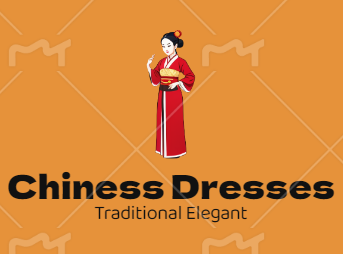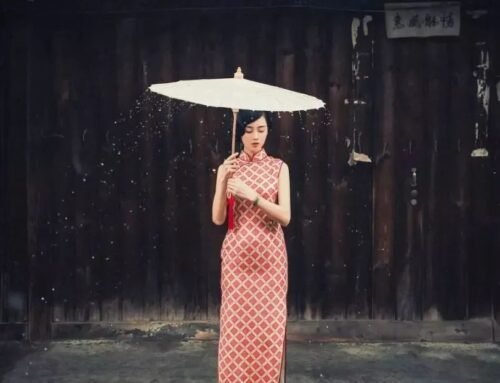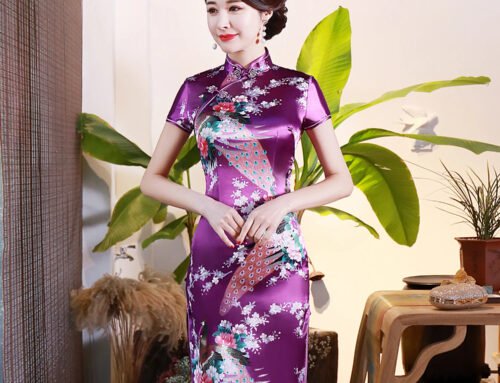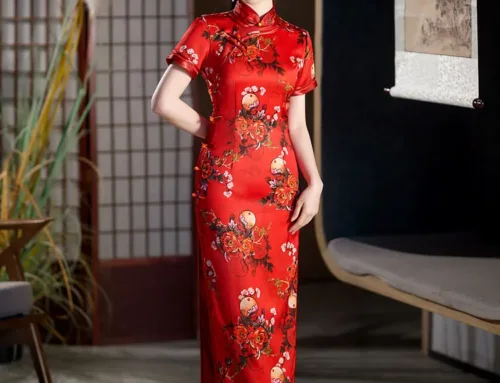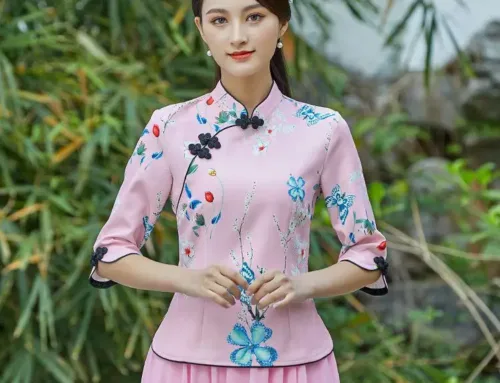
The charm of cheongsam: the most popular clothing for women during the Republic of China
The charm of cheongsam: the most popular clothing for women during the Republic of China
At the 2016 Hangzhou Cheongsam Exhibition, the cheongsam from the late Qing Dynasty and the cheongsam from the 1930s were displayed.

In today’s life, more and more women prefer cheongsam. The cheongsam, which has a traditional charm and can perfectly show off body curves, has become a fashion favorite.
For more people, the deepest impression of cheongsam is from the Republic of China period. Looking through old photos and movies from that period, you can see Soong Ching Ling, who was dignified and elegant in cheongsam, and movie stars Hu Die, Ruan Lingyu and others who looked proud in cheongsam.
In fact, this costume, which originated from the bannermen’s robes, showed the beautiful figures of Chinese women to the world for the first time. As soon as it appeared, the cheongsam became the favorite garment of high-ranking officials and common people during the Republic of China. In the subsequent development, a rich and colorful “cheongsam culture” was derived.

1 Developed from the bannermen’s robes
The cheongsam is not a Hanfu, but the robe of the banner people. Originally, both men and women of the Manchu nationality could wear cheongsam, but only the robes worn by the Eight Banners women on a daily basis are related to the later cheongsam.
The robes worn by bannermen in the early Qing Dynasty were rectangular in shape on the outside, with round necklines, narrow sleeves, buttoned loops, and the right side of the skirt was covered, and the armpits were significantly shrunk. The lower part of the robe is slit, the hem is wide, and the robe is long enough to cover the feet. The bannermen’s robes are cut from a single piece of clothing from top to bottom and are plain in color. In the middle of the Qing Dynasty, in addition to round collars, the robes of bannermen also had narrow stand-up collars. The body and sleeves of the robes were wider than in the early Qing Dynasty, and the hem of the robes generally hung down to the ankles.
In the Qing Dynasty, the shape lines of bannermen’s robes were mainly straight lines, without curves, giving people a straight and tough feeling. Moreover, the top and bottom of the robe are integrated, making the lines smoother. The robe can cover the feet. The natural feet of the Eight Banners women are hidden under the hem of the robe. Therefore, when the Banner women wear “flowerpot bottom” high-soled shoes, their waistline can be It is raised up and the lower limbs are also elongated, making the wearer look slim and graceful. In addition, the women of the Eight Banners often wear tall “ruyi head” and “drooped wings” false buns on their heads, which makes them look even more charming.
However, after all, the wide and heavy robe does not show off the curves, which still brings a lot of dissatisfaction to many women who love beauty. With the establishment of the Republic of China, clothing has also become a symbol of the innovation of the times. Mao suit appeared in men’s clothing. Women discovered the beauty of women’s clothing from the Manchu robes, abandoned the shortcomings of wide robes and large sleeves, and absorbed Western aesthetic tastes. The cheongsam. This new style of clothing boldly reflects the curvaceous beauty of the female body.
The popularity of cheongsam began in the early 1920s. The improved cheongsam in the early days of its popularity changed its wide and straight characteristics. The wide, straight-waisted (no waist) Manchu robes were designed to tighten the waist, reduce the cuffs, and form a waist to fit the curves of women’s bodies; secondly, the cheongsam’s The length is shortened. Manchus wear robes and often wear flowerpot-soled shoes four or five inches high. The hem of the robe must cover the soles, while the Han people wear flat shoes without high soles and no tall hair on their heads. The hem of the cheongsam is greatly shortened.
The improved cheongsam can not only highlight the body curves, but the slits in the cheongsam can also show off women’s legs, so it is very popular among women. In addition, the 1920s coincided with the rise of the feminist movement. The pursuit of equality between men and women, concepts such as letting go, haircuts, natural breasts, attending girls’ schools, and freedom of marriage also began to take root in the hearts of the people. After women left the family and entered society, they The competition to wear cheongsam makes the Chinese people who are used to seeing bannermen’s robes, Han women’s cardigans and coat skirts feel bright. It didn’t take long for women to follow suit. They pulled on a piece of fabric, not necessarily a high-end fabric, even an ordinary fabric, and with the skillful hands of a tailor, they cut out a cheongsam that fit the body.
However, the emergence of cheongsam has also gone through multiple stages of development. Zhang Ailing said: “The first cheongsam was cold and square, with a Puritan style.” The cheongsam at that time had a loose body, a straight silhouette, shrinking sleeves, and enlarged cuffs, forming an “inverted sleeve” shape.
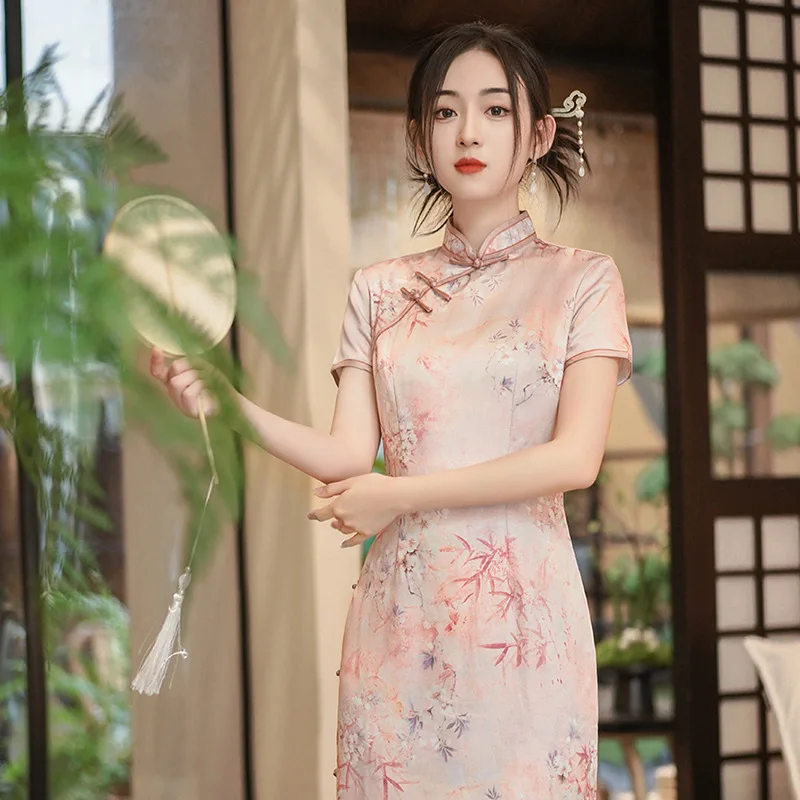
As early as the early part of the last century, “inverted big sleeves” was a relatively popular female clothing style. Women’s coats had inverted big sleeves (big-sleeved coats). In the late Qing Dynasty, aristocratic women’s cardigans also had inverted big sleeves. In terms of shape, the “civilized women’s clothing” popular among female students in the early years of the Republic of China also had inverted sleeves. Therefore, the original cheongsam was also combined with the style of inverted sleeves, forming the “inverted sleeves” cheongsam.
In the 1920s, some pictures about Soong Ching Ling included records of her wearing various styles of cheongsam with inverted sleeves. On December 21, 1923, Soong Ching Ling accompanied Sun Yat-sen to give a lecture at Lingnan University in Guangzhou. She wore a cheongsam made of black satin with large inverted sleeves, a plaid scarf around her neck, and a flower embroidered on the placket and cuffs. Sun Yat-sen passed away in Beijing on March 12, 1925. During the funeral, Soong Ching Ling wore a black long-sleeved cheongsam with inverted sleeves.
In a photo taken by Soong Ching Ling in 1925, the cheongsam she wore was a special cheongsam with inverted large sleeves. Judging from the edges of the cheongsam, it can be seen that the cheongsam is exquisitely made and is a masterpiece. However, by the 1930s, cheongsam styles emerged in endlessly, and cheongsams with large inverted sleeves were already rare.
At this time, the overall characteristics of cheongsam are small collar, small sleeves, and varied hem. The core is to pay attention to the waist. The cheongsam is tailor-made according to the different body shapes of the wearers, and the waist is placed and closed to reflect the close fit of the cheongsam. Looking through the photos from that year, you will be surprised to find that the cheongsam fits every woman who wears it, and there is absolutely no baggy feeling like the later uniforms. The reason is that cheongsam is a tailor-made and personalized clothing, which can be different for each person.

2. Cheongsam has many variations.
During the Republic of China, women’s cheongsam showed a variety of changes, mainly reflected in the changes in the length of the cheongsam’s hem, the width of the waist, the style of the collar, and the size of the sleeves.
Let’s talk about the neckline style first. First, low necklines became fashionable, and then high necklines became popular. Even in the scorching heat of summer, the thin cheongsam must still be paired with a high collar that reaches the ears to show fashion. Later, the neckline was so high that it reached the bottom of the palate and then reached the ears. Then low collars became popular. The lower the collar, the more modern it is. When it is too low and cannot be lowered anymore, it is also fashionable to not have a collar at all.
The length of the cheongsam hem may be long or short. When it is long, it covers the top of the feet, sweeping the floor along the clothes when walking, and when it is short, it is slightly above the knees. In the 1930s, cheongsam became popular with long hems that reached the floor and covered the feet. It was vividly called “floor-sweeping cheongsam.”

Long cheongsam is usually equipped with a high collar, which is tightly wrapped around the neck, and some even reaches the chin. Even in the hot summer, women wearing cheongsam still maintain their tall posture. Paired with high heels, the long cheongsam makes a woman’s figure appear slimmer. Considering that the cheongsam is worn close to the body and has inconvenience in movement, cheongsam began to have slits, especially the high slits, which just solved the problem of inconvenience in movement close to the body, and the high slits vaguely exposed the white thighs of women when walking around, exuding a flirtatious look. The human posture is very sexy.
In the 1930s, cheongsam and long pants gradually became popular. The so-called “big pants” only meant that the pants were above the knees at that time. Despite this, this kind of cheongsam was still criticized by the old-school people. However, cheongsams with exposed calves did not disappear; later, cheongsams were slit up to the hips, and the waist became narrower, allowing women’s beautiful legs to be fully displayed. However, after a few years of popularity, the cheongsam gradually fell back.
The sleeves of cheongsam change over time, rising and falling, sometimes longer than the wrist, sometimes as short as the elbow, and finally sleeveless.
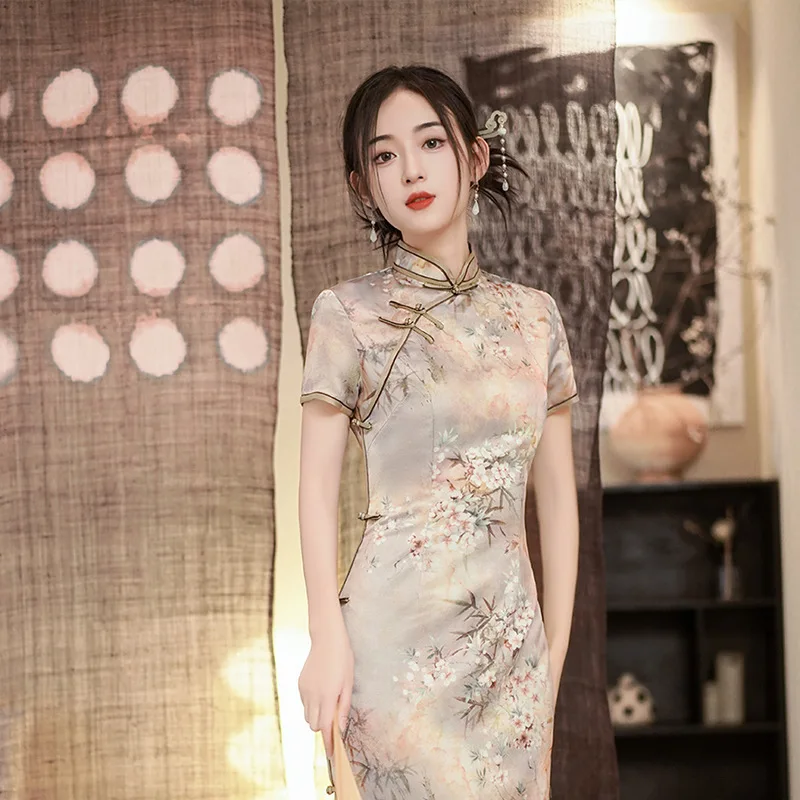
The second characteristic of the cheongsam at that time was that it was perfectly integrated with Western-style clothing, and it was tailored to fit. In addition to slits on both sides, it could also be slit in the front and back, and the cheongsam with left and right lapels appeared. In the late 1930s, there was an improved cheongsam. The cheongsam borrowed from Western clothing tailoring methods and had chest darts and waist darts (darts here specifically refer to the unique design of clothing). At the same time, shoulder seams and sleeves appear for the first time, making the shoulders and underarms more tailored. The emergence of improved cheongsam made the exquisite and abrupt female beauty become a social fashion. In addition, decorative elements of Western-style clothing such as ruffle sleeves and slit sleeves are also widely used.
This kind of cheongsam that combines Western style can be matched with all kinds of clothing. For example, in winter, a fur coat can be worn outside a cheongsam, and fur trim can be added to the collar and sleeves of the cheongsam. These were all fashionable ways of wearing them at the time.
3. Indanthrine cheongsam is popular all over the country
With the development of cheongsam, there were two major schools of cheongsam production: Beijing style cheongsam and Shanghai style cheongsam. Because the birthplace of cheongsam is Beijing, at the initial stage, the improved cheongsam that incorporated Han elements such as stand-up collars and slits on the left and right sides was called Beijing style cheongsam; later, the cheongsam was changed from flat cutting to three-dimensional cutting, and the waist and other fashionable elements were added to the cheongsam. It’s called Shanghai-style cheongsam. The slender and fit-fitting characteristics of Shanghai-style cheongsam just catered to the thin and exquisite figure characteristics of southern women, and it became a clothing fashion. It gradually replaced the Beijing-style cheongsam.
Of course, the two factions are mainly distinguished by style, not simply by region. That is to say, not only the cheongsam in Beijing is Beijing style cheongsam, but the cheongsam in Shanghai is Shanghai style cheongsam. Beijing style and Shanghai style represent two styles in art and culture. The Shanghai-style style is characterized by the absorption of Western art, with flexible and diverse forms and a strong commercial atmosphere; the Beijing-style style has an official style and appears reserved and concise.
In recent years, some people have proposed the concept of “Su style cheongsam”, that is, Jiangsu cheongsam. This is a new term. It is mostly a concept of commercial speculation. It is not the same concept as the Beijing style cheongsam and Shanghai style cheongsam during the Republic of China. During the Republic of China, because Nanjing was the capital, its cheongsam style was widely popular. However, the production style of Nanjing cheongsam still belongs to the Shanghai style, but the specific style of production is slightly different from that of Shanghai cheongsam.
During the Republic of China, the cheongsam was the most representative clothing for women, and its applicability was very wide. From noble women to common people and housewives, everyone can wear cheongsam. Cheongsams can be worn by a wide range of age groups, from teenage girls to grandmothers in their seventies and eighties. Moreover, cheongsam can be worn all year round, and its shape can be single, clipped, or cotton. There are single cheongsams in summer, cotton cheongsams in winter, and sandwich cheongsams in spring and autumn, which can also be worn with other clothing. Cotton cheongsam in autumn and winter has long sleeves and a long hem, emphasizing warmth over fashion.
Moreover, cheongsam has a wide range of matchability, is less affected by seasonal factors, and can be matched with a variety of clothing. When the weather is cool, a short vest or woolen sweater can be added to the cheongsam. In winter, a fur coat can be worn outside the cheongsam, with fur trim on the collar and sleeves. In addition, cheongsam can be perfectly matched with fashion items such as scarves, stockings, necklaces, earrings, watches, leather bags, high heels, etc. Because of this, cheongsam became the favorite of women in the Republic of China. They are all dressed elegantly and attract the attention of the world.
At that time, among various styles of cheongsam, indanthrine cheongsam was particularly popular. The so-called indanthrene cheongsam meant that the fabric of the cheongsam was made of indanthrene cloth.
Indanthryne is originally the name of a kind of vat dye. Its vat dye is washable and light-fast, and the fabrics dyed with it are colorful, so people are accustomed to call it indanthrene cloth. Among them, the products produced by Dade Dye Factory are the most famous. Compared with traditional homespun cloth, indanthrine cloth has bright colors, wide variety and good quality. In addition, compared with pure foreign cloth, it looks simple and elegant, economical and durable, and can meet the needs of middle, high and low-level customers, so it is very popular among people.
At that time, the advertisements for indansilin were very popular in urban and rural areas, and had a particularly great impact on students. Indanthrine cloth also sells well all over the country due to its excellent quality and is well-known to every household. Students competed to wear uniforms made of indanthrene cloth, and fashionable girls also wore cheongsams made of indanthrene cloth. Indanthrene cloth has almost become the “national cloth”. To this day, indanthrine, Shilin blue, and Shilinbu are still familiar words to many elderly people.
4 “The Thirteen Beauties of Jinling” uses the wrong word “floor-sweeping cheongsam”
It is worth mentioning that wearing cheongsam emphasizes the effect of pushing forward and pushing back, that is, the chest is straight and the buttocks are upturned, so that the female curves are perfectly presented. Therefore, for women with flat chests, the performance of cheongsam will be greatly reduced. Therefore, during the Republic of China, in order to change the shortcomings of flat breasts, some women stuffed cotton on their chests to make their breasts protrude, and some women cut small leather balls in half to make fake breasts.
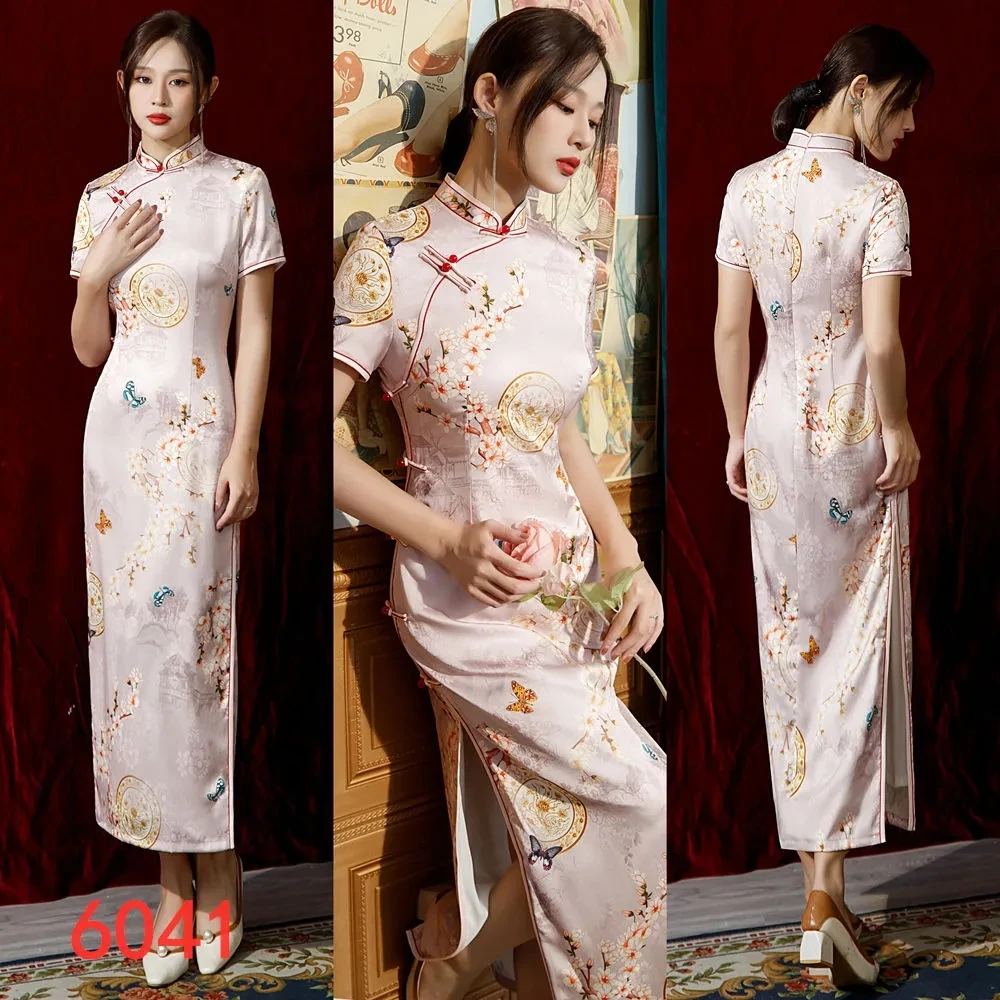
In the late 1920s, bras came across the ocean to China. At that time, people called them “prosthetic breasts.” However, it is still difficult for Chinese women to accept Western-style bras immediately. Therefore, some female movie stars at that time became fashion pioneers and tried on bras. Ruan Lingyu, who is famous in the film industry for starring in films such as “The Goddess” and “New Woman”, was one of the first Chinese women to wear “prosthetic breasts”. After she put on the “prosthetic breasts”, she looked graceful and graceful in her cheongsam, and many women began to accept bras. Not only are more and more women showing off the beauty of their body curves, but it has also changed the long-standing status quo of Chinese women without well-fitting underwear.
In the 1930s, cheongsam reached its peak. Almost all women loved cheongsam and wore cheongsam. Women wearing cheongsam can be seen in social places, middle schools and universities, shops and even in ordinary alleys. In the 1930s, “floor-sweeping cheongsam” was very popular. The so-called “floor-sweeping cheongsam”, also known as “floor-length cheongsam”, as the name suggests, is because the hem of the cheongsam reaches to the ankles, covering the feet and even dragging to the ground, making it look like sweeping the floor when walking. This kind of cheongsam is a cheongsam dress and is mostly used in social occasions. It is a cheongsam often worn by socialites. They are rarely worn in daily life because of limited mobility.
“The Thirteen Hairpins” directed by Zhang Yimou is a film that reflects the Nanjing Massacre. The cheongsam in the film is very beautiful and has a strong visual impact. Unfortunately, the wrong “floor-sweeping cheongsam” was used.
The cheongsam in “Jinling Thirteen Hairpins” is mainly a “floor-sweeping cheongsam” with long sleeves and a slit in the hem (slit to the calf). The “floor-sweeping cheongsam” became popular around 1934. The film shows the fall of Nanjing in 1937. At this time, the “floor-sweeping cheongsam” was not the mainstream cheongsam in society. Moreover, the sleeves of “sweeping cheongsam” are not limited to long sleeves, but also have medium sleeves, short sleeves and sleeveless. What’s more, during the war years, especially during the occupation period, it was not very likely for women to wear “floor-sweeping cheongsam” for ease of movement.
In a specific period, cheongsam is not only fashionable, but also reflects patriotism. Especially when foreign enemies invade, wearing cheongsam also becomes one of the manifestations of defending homeland. During the Anti-Japanese War, the economy was depressed and supplies were scarce. Most of the people were protecting their homes and the country. They were not interested in extravagant clothing and strived to be thrifty in clothing. In the past, the elegant and luxurious cheongsam omitted all kinds of tedious decorations and became simple and suitable for the body. At that time, it was popular to use domestic white or woolen blue cloth (also known as “patriotic cloth”) to make cheongsam. In the 1940s, a simple cheongsam became popular among female factory workers. It was shaped like a round hole dug into a flour bag. It was sleeveless, collarless or low-collared. It had no waist, small slits, and the length was above and below the knees. It was extremely light.
The overall characteristics of cheongsam in the 1940s were that the length was shortened, the body exposure was increased, and simple cheongsam became popular. Moreover, as the cost of cheongsam decreased, Chinese women revealed their natural beauty in simplicity, and simplicity and elegance became the fashion of this period.

5 Zhang Ailing is a “cheongsam fan”
Among women in the Republic of China, Soong Meiling and Zhang Ailing can be described as absolute “cheongsam fans.” The two of them are particularly fond of cheongsam.
Although Song Meiling has been living in the United States since she was 10 years old, she has always worn Chinese clothes. She doesn’t like to wear clothes that are too revealing.
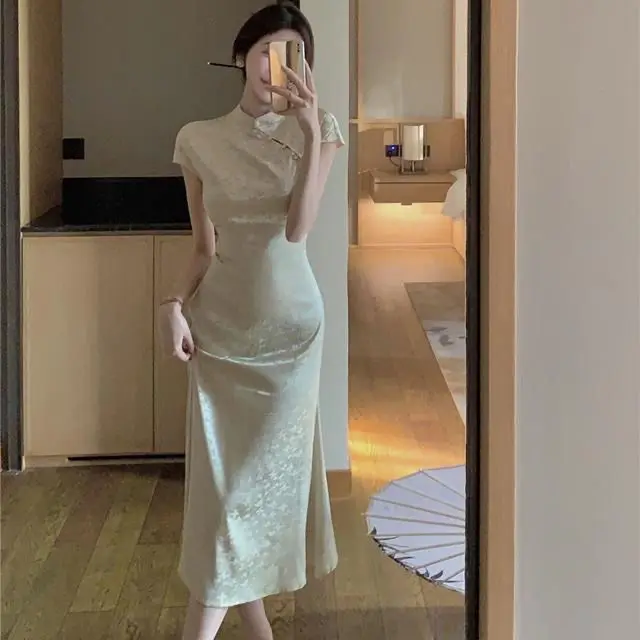
Views: 0
About the author : chinese-dresses.com
Find Us On Facebook
Tags
Views: 0
